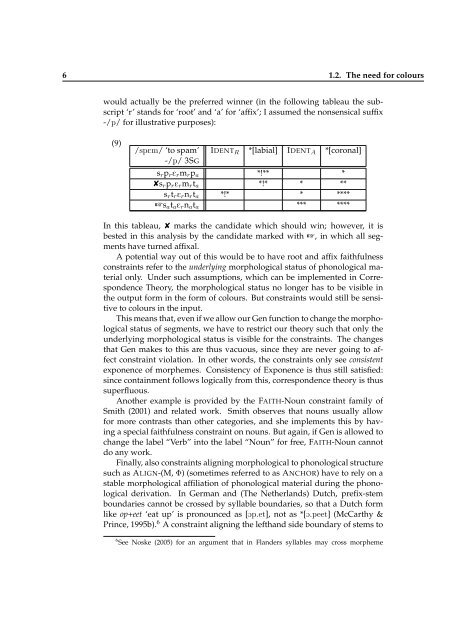Derived Environment Effects and Consistency of ... - Linguistics
Derived Environment Effects and Consistency of ... - Linguistics
Derived Environment Effects and Consistency of ... - Linguistics
Create successful ePaper yourself
Turn your PDF publications into a flip-book with our unique Google optimized e-Paper software.
6 1.2. The need for colours<br />
would actually be the preferred winner (in the following tableau the subscript<br />
‘r’ st<strong>and</strong>s for ‘root’ <strong>and</strong> ‘a’ for ‘affix’; I assumed the nonsensical suffix<br />
-/p/ for illustrative purposes):<br />
(9)<br />
/spEm/ ‘to spam’ IDENTR *[labial] IDENTA *[coronal]<br />
-/p/ 3SG<br />
srprErmrpa *!** *<br />
✘srprErmrta *!* * **<br />
srtrErnrta *!* * ****<br />
☞sataErnata *** ****<br />
In this tableau, ✘ marks the c<strong>and</strong>idate which should win; however, it is<br />
bested in this analysis by the c<strong>and</strong>idate marked with ☞, in which all segments<br />
have turned affixal.<br />
A potential way out <strong>of</strong> this would be to have root <strong>and</strong> affix faithfulness<br />
constraints refer to the underlying morphological status <strong>of</strong> phonological material<br />
only. Under such assumptions, which can be implemented in Correspondence<br />
Theory, the morphological status no longer has to be visible in<br />
the output form in the form <strong>of</strong> colours. But constraints would still be sensitive<br />
to colours in the input.<br />
This means that, even if we allow our Gen function to change the morphological<br />
status <strong>of</strong> segments, we have to restrict our theory such that only the<br />
underlying morphological status is visible for the constraints. The changes<br />
that Gen makes to this are thus vacuous, since they are never going to affect<br />
constraint violation. In other words, the constraints only see consistent<br />
exponence <strong>of</strong> morphemes. <strong>Consistency</strong> <strong>of</strong> Exponence is thus still satisfied:<br />
since containment follows logically from this, correspondence theory is thus<br />
superfluous.<br />
Another example is provided by the FAITH-Noun constraint family <strong>of</strong><br />
Smith (2001) <strong>and</strong> related work. Smith observes that nouns usually allow<br />
for more contrasts than other categories, <strong>and</strong> she implements this by having<br />
a special faithfulness constraint on nouns. But again, if Gen is allowed to<br />
change the label “Verb” into the label “Noun” for free, FAITH-Noun cannot<br />
do any work.<br />
Finally, also constraints aligning morphological to phonological structure<br />
such as ALIGN-(M, Φ) (sometimes referred to as ANCHOR) have to rely on a<br />
stable morphological affiliation <strong>of</strong> phonological material during the phonological<br />
derivation. In German <strong>and</strong> (The Netherl<strong>and</strong>s) Dutch, prefix-stem<br />
boundaries cannot be crossed by syllable boundaries, so that a Dutch form<br />
like op+eet ‘eat up’ is pronounced as [Op.et], not as *[O.peet] (McCarthy &<br />
Prince, 1995b). 6 A constraint aligning the lefth<strong>and</strong> side boundary <strong>of</strong> stems to<br />
6 See Noske (2005) for an argument that in Fl<strong>and</strong>ers syllables may cross morpheme

















